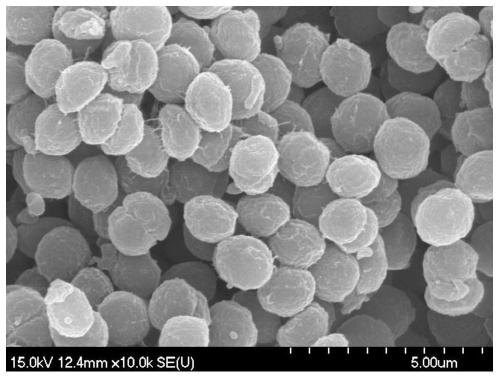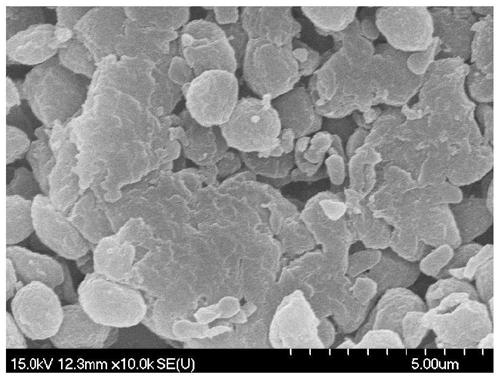Method and strain for remediating arsenic polluted high-salinity alkaline water through Synechocystis sp. in situ
An in-situ remediation and saline-alkali water technology, applied in the direction of microorganism-based methods, water pollutants, chemical instruments and methods, etc., can solve the problems of arsenic desorption, secondary release of arsenic, etc. High adaptability and ideal treatment effect
- Summary
- Abstract
- Description
- Claims
- Application Information
AI Technical Summary
Problems solved by technology
Method used
Image
Examples
Embodiment 1
[0026] The separation and identification of embodiment 1 cyanobacteria
[0027] 1. Separation of cyanobacteria: Separation of cyanobacteria from arsenic-contaminated water body soil, sediment, water and algae biofilm in saline-alkali areas.
[0028] (1) Cultivation: Weigh 5g (wet weight, no drying) of soil and sediment removed from impurities and add them to a 250mL Erlenmeyer flask, add 50ml of water samples from Xinjiang Kuitun 123 group alkali drainage canal (salinity 15‰, pH8 .24), then add 100mL of sterilized NaCl with a final concentration of 5‰ (5g / L) and a final concentration of 5mg / L NaAsO 2 and 36mg / L CaCl 2 2H 2 The BG11 liquid culture medium of O was cultivated under the conditions of temperature of 25°C, light intensity of 2000lux, and light / darkness of 12h / 12h. When algae grow in the culture solution, the culture solution is mixed with sterile water by 10 -1 、10 -2 、10 -3 , 10 -4 、10 -5 、10 -6 Concentration gradient dilution, use a coating bar to coat in...
Embodiment 2
[0045] (1) Preparation of cyanobacteria: Inoculate cyanobacteria CCTCC NO: M 2019135 into 500ml containing 36mg / L CaCl 2 2H 2 In the Erlenmeyer flask of the BG11 liquid culture medium of O, and be placed on 25 ℃, light intensity 2000lux, light / darkness are in 12 / 12 environment, cultivate to logarithmic growth phase, obtain culture fluid (cyanobacteria OD 685 =0.7), the culture solution was centrifuged at 5500rpm for 20min, and after the supernatant was removed, the bacterial cell precipitate was collected, which was the cyanobacterial cell. Take a small amount of thalline precipitation, fix the cells with 2.5% aqueous solution of pentanediol with a mass concentration, after dehydrating with ethanol, dry in a freeze dryer (-80°C, vacuum environment) for 48h, take it out, and observe the cyanobacteria thallus by SEM, as figure 1 .
[0046] (2) Restoration of simulated water samples polluted by high salinity and alkali arsenic: BG11 liquid culture medium added with 25g / L NaCl a...
Embodiment 3
[0050]The NaCl concentration is adjusted to 35g / L in embodiment 2, other is the same as embodiment 1, carries out repair and the inspection of stability, the result shows, through laboratory simulation arsenic polluted water experiment, be 35g / L in salt content, different arsenic pollution Level (10mg / L, 20mg / L, 40mg / L) of the water environment, using cyanobacteria CCTCC NO: M 2019135, after 14 days of in-situ restoration, the removal rate of arsenic reached 73.67%, 74.84%, 73.48% respectively . After the stability detection of arsenic pollution in the laboratory, in a 35g / L saline environment, using the simulated arsenic-contaminated water sample repaired by the described cyanobacteria, after evaporation and redissolving, different arsenic pollution levels (10mg / L, 20mg / L, 40mg / L) still maintained a good removal rate, respectively: 51.02%, 47.17%, 45.71%.
[0051] According to the method of the present invention, through laboratory simulation of high salinity arsenic contam...
PUM
| Property | Measurement | Unit |
|---|---|---|
| Cell diameter | aaaaa | aaaaa |
Abstract
Description
Claims
Application Information
 Login to View More
Login to View More - R&D
- Intellectual Property
- Life Sciences
- Materials
- Tech Scout
- Unparalleled Data Quality
- Higher Quality Content
- 60% Fewer Hallucinations
Browse by: Latest US Patents, China's latest patents, Technical Efficacy Thesaurus, Application Domain, Technology Topic, Popular Technical Reports.
© 2025 PatSnap. All rights reserved.Legal|Privacy policy|Modern Slavery Act Transparency Statement|Sitemap|About US| Contact US: help@patsnap.com


